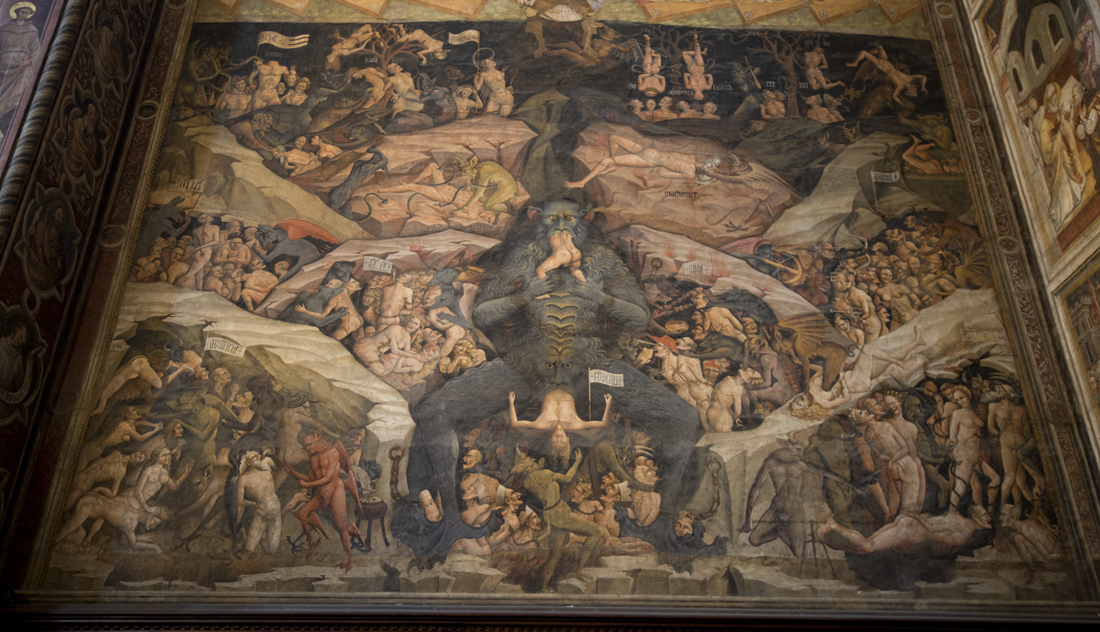The Demise of the Devil
For our struggle is not against flesh and blood, but against the rulers, against the powers, against the world forces of this darkness, against the spiritual forces of wickedness in the heavenly places. Ephesians 6:12 NASB
Spiritual forces of wickedness – Churches before the Reformation were visual reminders of the power of Satan and the specter of Hell. When you entered, you almost always found something like this:

You don’t see anything like this anymore. Now the sanctuary is filled with “love” banners, signs of peace and happiness, forgiveness motifs, and a God who is the heavenly version of Santa Claus. What happened? Did Luther and Calvin get God into anger management classes? Not likely! Something much more fundamental occurred, as important as the shift from an experiential spiritual foundation to the Hellenized cognitive foundation of a canonized text. The Western world replaced the spiritual realm with science, but not just any science. The spiritual realm was replaced with a commitment to a science that operated only in the world of rational, empirical cause and effect. Robert Lenoble notes, “ . . . modern thought has created a type of horizontal explanation, in terms of equivalent effects and causes, all situated on the same level of empirical data, and this way of thinking has replaced the kind of vertical explanation that prevailed at an earlier time, and that linked visible effects to transcendent causes.”[1] Paul’s comment about powers and principalities in heavenly places is not just antiquated; it’s nonsensical.
But it wasn’t nonsense to Paul and his contemporaries, or to anyone in the ancient world, for that matter. The ancient world was vertically integrated. There was no sharp distinction between the earthly realm of human beings and the heavens above or the pit below. Persons, actions, and incantations traveled easily across one realm to the other. For Paul, as for the author of Hebrews, the earth merely reflected (or shadowed) the other realms. If we’re going to understand Paul’s language, we will have to think in terms of a permeable, vertical universe. As soon as we convert the vertical to a fixed horizontal ontology, empirical cause and effect replace everything divine.
What’s the lesson? Well, for one thing we might consider the fact that Paul simply doesn’t think like us! There is no point in trying to convert his idea of powers and principalities into our idea of political, economic, or social contexts. It is just as mistaken to imagine that the Devil lurks around the corner, that evil in the world is really the result of invisible dark forces, or that we can pray our way into utopia. This is what Wittgenstein called “a category mistake.” “Spiritual forces of wickedness” exist in Paul’s vertical world, not in the West’s horizontal world. If you try to find evidence for Paul’s world among those who believe that the world is flat (I mean, horizontal, not “flat-earth”), you won’t get anywhere. The “evidence” is incompatible with the paradigm. If you want to talk about powers and principalities in high places, you’ll need to talk with people who share a vertical cosmology. And if you start talking with them and try to enlist “evidence” from the horizontal cosmology, you’ll be talking gibberish.
If you believe in a vertical universe, then be prepared for pictures like the one from the Duomo in Bologna. If you don’t like that (in concept, not in visual imagery), then you’re not really in the vertical universe. You can’t have Heaven without Hell, but you can opt for a world without either. You might be wrong, of course.
Topical Index: powers and principalities, horizontal universe, cause and effect, Devil, Ephesians 6:12
[1] Robert Lenoble, Historie de l’idee de nature, p. 245., cited in Fernand Hallyn, The Poetic Structure of the World: Copernicus and Kepler (trans. Donald M. Leslie, Zone Books, 1993), p. 19.



